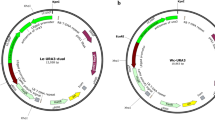Abstract
The fungus Slafractonia leguminicola, the causal agent of blackpatch disease of legumes produces two mycotoxins slaframine and swainsonine, causing slobbers’ symptoms and locoism of grazing animals, respectively. The genetics of this important fungus is poorly understood. This work aimed to develop a genetic transformation system and evaluate the efficacy of RNA interference (RNAi) in S. leguminicola. In this study, S. leguminicola was transformed using a PEG-mediated method with a fungal construct that carries a hygromycin resistance cassette. To assess the use of RNAi, a silencing construct pSilentPKS1-AS was constructed which includes inverted repeat transgenes of the polyketide synthase gene (pks1) that is involved in melanin biosynthesis. Transformation of S. leguminicola with the IRT pks1 vector decreased pks1 transcripts levels 82–92% in knockdown mutants when compared with the wild type and was accompanied with a reduction in melanin and swainsonine production. These results demonstrate that RNAi can be a useful tool for studying gene function in S. leguminicola.






Similar content being viewed by others
References
Ahlquist P (2002) RNA-dependent RNA polymerases, viruses, and RNA silencing. Science 296:1270–1273
Akamatsu HO, Chilvers MI, Stewart JE, Peever TL (2010) Identification and function of a polyketide synthase gene responsible for 1,8-dihydroxynaphthalene-melanin pigment biosynthesis in Ascochyta rabiei. Curr Genet 56:349–360
Akihiro M, Makoto U, Sakae A, Junichi K (2007) RNA-mediated gene silencing in the phytopathogenic fungus Bipolaris oryzae. FEMS Microbiol Lett 269:85–89
Alhawatema SM, Sanogo S, Baucom DL, Creamer R (2015) A search for the phylogenetic relationship of the ascomycete Rhizoctonia leguminicola using genetic analysis. Mycopathologia 179:381–389
Aust SD (1974) Rhizoctonia leguminicola-slaframine. In: Purchase IFH (ed) Mycotoxins. Elsevier, Amsterdam, pp 97–109
Aust SD, Broquist HP, Rinehart KL Jr (1966) Slaframine. Structural studies of a parasympathomimetic alkaloid of fungal origin. J Am Chem Soc 88:2879–2880
Bdel-Hadi AM, Caley DP, Carter DRF, Magan N (2011) Control of aflatoxin production of Aspergillus flavus and Aspergillus parasiticus using RNA silencing technology by targeting aflD (nor-1) gene. Toxins 3:647–659
Bernstein E, Caudy A, Hammond S, Hannon G (2001) Role for a bidentate ribonuclease in the initiation step of RNA interference. Nature 409:363–366
Braun K, Romero J, Liddell C, Creamer R (2003) Production of swainsonine by fungal endophytes of locoweed. Mycol Res 107:980–988
Cook D, Donzelli BGG, Creamer R, Baucom DL, Gardner DR, Pan J, Moore N, Krasnoff SB, Jaromczyk JW, Schardl CL (2017) Swainsonine biosynthesis genes in diverse symbiotic and pathogenic fungi. G3 (Bethesda) 7:1791–1797
Croom WJ, Hagler WM, Froetschel MA (1995) The involvement of slaframine and swainsonine in slobbers syndrome: a review. Anim Sci 73:1499–1508
Crump MH, Smalley EB, Henning JN, Nichols RE (1963) Mycotoxicosis in animals fed legume hay infested with Rhizoctonia leguminicola. J Am Vet Med Assoc 143:996–997
Gardner DR, Cook D (2010) A comparison of alternative sample preparation procedures for the analysis of swainsonine using LC-MS/MS. Phytochem Anal 2:124–127
Gough FJ, Elliott ES (1956) Blackpatch of red clover and other legumes caused by Rhizoctonia leguminicola. W Va Agric Exp Stn Bull 387:1–23
Guengerich FP, Broquist HP (1973) Biosynthesis of slaframine, (1S, 6S, 8aS)-1-acetoxy-6-aminooctahydroindolizine, a parasympathomimetic alkaloid of fungal origin. II. The origin of pipecolic acid. Biochemistry 12:4270–4274
Guengerich FP, Snyder JJ, Broquist HP (1973) Biosynthesis of slaframine, (1S, 6S, 8aS)-1-acetoxy-6-aminooctahydroindolizine, a parasympathomimetic alkaloid of fungal origin. I. Pipecolic acid and slaframine biogenesis. BioChemistry 12:4264–4269
Hagler WM, Croom WJ (1989) Slaframine: occurrence, chemistry, and physiological activity. In: Cheeke PR (ed) Toxicants of plant origin, Volume I, Alkaloids. CRC Press, Boca Raton, FL, pp 257–279
Kawamura C, Moriwaki J, Kimura N, Fujita Y, Fuji S, Hirano T, Koizumi S, Tsuge T (1997) The melanin biosynthesis genes of Alternaria alternata can restore pathogenicity of the melanin-deficient mutants of Magnaporthe grisea. Mol Plant Microbe Interact 10:446–453
Li QQ, Skinner J, Bennett JE (2012) Evaluation of reference genes for real-time quantitative PCR studies in Candida glabrata following azole treatment. BMC Mol Biol 13:22
Liu H, Cottrell TR, Pierini LM, Goldman WE, Doering T (2002) RNA interference in the pathogenic fungus Cryptococcus neoformans. Genetics 160:463–470
Mouyna I, Henry C, Doering TL, Latge JP (2004) Gene silencing with RNA interference in the human pathogenic fungus Aspergillus fumigatus. FEMS Microbiol Lett 237:317–324
Nakayashiki H, Hanada S, Nguyen BQ, Kadotani N, Tosa Y, Mayama S (2005) RNA silencing as a tool for exploring gene function in ascomycete fungi. Fungal Genet Biol 42:275–283
O’Neill NR, Brooker N, Lydon J, Sauders JA (1998) Transformation of Colletotrichum trifolii protoplasts by electroporation and PEG mediated DNA uptake. Recent Res Dev Plant Pathol 2:1–15
Salame TM, Ziv C, Hader O, Yarden Y (2011) RNAi as a potential tool for biotechnological applications in fungi. Appl Microbiol Biotechnol 89:501–512
Smalley EB, Nichols RE, Crump MH. Henning JN (1962) A physiological disturbance in animals resulting from ingestion of Rhizoctonia leguminicola infested red clover forage. Phytopathology 52:753
Wickwire BM, Harris CM, Harris TM, Broquist HP (1990) Pipecolic acid biosynthesis in Rhizoctonia lequminicola. Biol Chem 265:14748 – 1475
Zamore P, Tuschl T, Sharp P, Bartel D (2000) RNAi: double-stranded RNA directs the ATP-dependent cleavage of mRNA at 21 to 23 nucleotide intervals. Cell 101:25–33
Acknowledgements
This work was financially supported by the New Mexico State University Agricultural Experiment Station and the Molecular Biology Graduate Program. The authors thank the Fungal Genetics Stock Center for kindly providing the fungal silencing vector pSilent-1.
Author information
Authors and Affiliations
Corresponding author
Rights and permissions
About this article
Cite this article
Alhawatema, M.S., Gebril, S., Cook, D. et al. RNAi-mediated down-regulation of a melanin polyketide synthase (pks1) gene in the fungus Slafractonia leguminicola . World J Microbiol Biotechnol 33, 179 (2017). https://doi.org/10.1007/s11274-017-2346-y
Received:
Accepted:
Published:
DOI: https://doi.org/10.1007/s11274-017-2346-y




